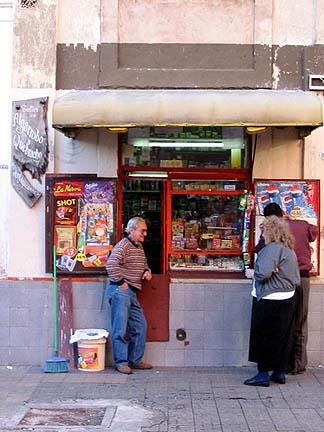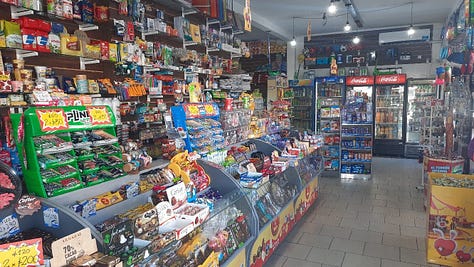Spring has arrived in Buenos Aires and it’s absolutely beautiful here. For most of my life, my October birthday occurred in the fall🍁…but now it’s in the spring🌸, and I have to say it’s really nice this way. And in a way, turning 50 feels like a new beginning, so the change of season is perfect.
With such nice weather, I’ve been walking around quite a bit, which got me thinking: In previous posts, I’ve told you about some of the staples of any neighborhood in Argentina: the bakery, the ice cream parlor, the pizzería. But I’ve yet to tell you about the most essential, although the tiniest of all: el kiosco.
What is a kiosco exactly? Is it a candy store, a convenience store, a hot-dog stand, or a place to charge your subway card? Or is it a cigarette stand, a place to make a phone call, get coffee on the go, or somewhere you can leave your house key for a relative to pick up later? You’ve probably guessed that it’s all of these things…but there’s much more, so let’s get into it.
I could tell you that a recent survey shows that there are over 110,000 kioscos in Argentina, which is one for every 400 inhabitants. Or I could tell you that they’ve been around since the early 20th century when cigarette vendors decided to set up right next to streetcar stops, or that Greek immigrants brought candy into the picture, as well as the name, which comes from the Turkish word kösk.
But I’d rather tell you about my personal experiences.
After a lifetime of rushing into bodegas and delis, ordering coffee and rushing out, I had to learn to be patient, slowly cleansing myself of the indifference and hurry New York imprinted on me. I learned to let the old lady ahead of me finish telling the kiosquero about her son, or whatever other important topic of the day. And once it was my turn, I learned to say “good morning” and “how are you” before “I’ll take two of these.”
I could also tell you how many times I’ve been saved late at night, coming home from a gig, by one of the neon kiosco signs, glimmering halfway down some dark street like an oasis in the desert. Whenever I see one of these humble, shining beacons I know I can fight off my hunger with an alfajor, or drink my favorite soda (grapefruit). I’ve even been able to grab a sandwich in the wee hours thanks to one of these little signs.
It’s personal.



Traditionally kioscos are family-owned, and it’s been said that they are great tools for fighting economic crises. This makes sense: If you think about it, all you really need is a window facing the sidewalk and something to sell.
During the pandemic I saw a number of improvised window-based businesses springing up. And when it’s small and neighborhood-based, it’s going to be personal. Ask any Argentine if they have a regular kiosco, and I think you’ll get a passionate response. I have one, and I think I’m in there three or four times a week. The prices are great, it’s owned by a family, and if you want you can stand there and chat with the person behind the counter about your life, their life, fútbol, or the latest crisis. You can really develop a trusting relationship with your kiosquero. I’ve heard stories of people entrusting their local shop owner with keys, packages, and much more.
What’s in a name?
If you’re a regular reader of Liner Notes you know about Argentinian creativity which, as it happens, is on full display when it comes to naming kioscos.
Here are a few of the greatest kiosco names I’ve seen. (I’ve omitted any that are named after children or grandchildren, which is sweet but unoriginal). Honorable mentions: “La Boina” is indeed attended by an old man wearing a boina (cap). “El Sonámbulo” (the sleepwalker) is open late and has gotten me out of more than one jam. Disqualified from this contest are two chains which have kioscos all over Buenos Aires: “Open 25 and “365.”
There is, however, one kiosco chain with a great story: “El Jevi” was founded by a Ukrainian immigrant who is a huge Heavy Metal fan. He’s known as “El Jevi” (pronounced “heavy”), and his signs use the fonts of his favorite bands.
Tied for first place are two whoppers straight from my neighborhood. The first is “No Tengo” which means “I don’t have it.” The owners are making fun of one of the most ubiquitous kiosco practices: a hand-made sign on the window letting people know you’re out of something as if to say “I’m out of ice so don’t ask.” The “No Tengo” folks named their entire business “I don’t have it,” and it’s printed up there on the sign, appealing, I suppose, to porteño’s sense of irony.
The other winner bears witness to Argentina’s obsession with TV show “The Simpsons” in which one of the characters, Apu, works at a convenience store. You guessed it, the sign shows features the legendary cartoon character and reads: “Maxikiosco Apu”
Getting conceptual
Did you notice that prefix, maxi? Are we talking about a gigantic store? Well, no.
If it’s big enough to walk into, it’s called maxikiosco, meaning that a true kiosco is so small that you’re out on the sidewalk, pointing at what you want to the person on the other side. This is an important distinction, and it goes back to my earlier point about the simplicity and ingenuity of a window-based business. It’s a wonderful tool for survival, setting up shop out of the window of your own home.
It’s smart, it’s personal, and it’s territorial, which leads us into conceptual terrain, into the realm of the kiosco as a metaphor.
When you say that so-and-so has “set up their kiosquito,” or their “little kiosco,” you’re referring to a business situation, a scheme, a cash cow which someone has established, holds dearly, and probably defends jealously. In English we might say “he has a little racket going” or “runs a fiefdom.” There are many examples of metaphorical kioscos. For example: a musician runs a live event on Saturday where amateurs can sign up to sign with professional accompaniment, and then from Monday to Friday day take a music lesson. The cycle repeats weekly. “That’s a nice kiosquito he has,” you might say.
Ok, you get the idea. I’m going to stop writing now because I need to run down to the corner…
Reading happens in all sorts of places. Recently I was backstage at a performance of Mozart’s “Cosi Fan Tutte” (long story), with tons of time to kill, so I decided to check out Arnold Schoenberg’s book Style And Idea. Schoenberg is best known as the pioneer of music which is really, really difficult for most people to listen to, but he was also truly versed in traditional music composition, and a fantastic thinker. Here is one of my favorite parts of the book, where he describes the concept of “idea” and why it’s so important. The idea behind a pair of pliers is ingenious, even if much more complicated machinery has been invented since:
The idea of fixing the crosspoint of the two crooked arms so that the two smaller segments in front would move in the opposite direction to the larger segments at the back, thus multiplying the power of the man who squeezed them to such an extent that he could cut wire--this idea can only have been conceived by a genius.
The tool itself may fall into disuse, but the idea behind it can never become obsolete….an idea can never perish.
The same goes for creating art - it’s not brilliant technique that moves us…it’s the ideas.
♫♪𝄞⨾𓍢ִ໋ of the week
Terrazas - La Runfla
My friends in La Runfla just put out a new album and I remember meeting them a little over two years ago when I asked them to be part of an album I was producing called Veni que te cuento. Here’s the track they created for that project which is now a regular part of their set. Veni is a concept album where ten women singers tell their stories (in 2022) to tango legends Tita Merello and Ada Falcón who both died in 2002.
Apología tanguera - Rosita Quiroga
Speaking of women tango singers past and present, here’s one of my favorites. Rosita Quiroga is possibly the most rootsy of them all, with a direct stylistic lineage to the folkloric music which preceded tango. Apología tanguera is her composition, and I’m pretty sure she’s playing guitar along with the bandoneón in this version.
Amanecer borincano - Ramito y Maso
There’s a beautiful island with a rich musical culture. It’s called Puerto Rico. One of my favorite all-time recordings of jíbaro music (one of several styles of traditional music) is of the singer Ramito and the cuatro player Maso Rivera. I recommend checking out the whole album. One more thing: Puerto Ricans are U.S. citizens…they vote.





Hi! You are right on target about the kiosco. One thing I like to add (which you mentioned briefly) is that there is a huge difference between those kioscos operated by the owner, always friendly, and the awful chain outlets, like Open 25, where a bored and underpaid kid is spending a useless night.
I didn't know about the Greek-Turkish connection of the word, good find!
Yes, I love Rosita Quiroga, she sounds pure tango. I believe that recording of Apología Tanguera includes Ciriaco Ortiz on bandoneón and Edmundo Zaldívar on guitar. No wonder it sounds great! Rosita Quiroga was also a very good dancer; watch her doing some wonderful canyengue here: https://www.youtube.com/watch?v=VjNPsRsjw9E and https://www.youtube.com/watch?v=INSUl6P9Yao.
Chau, un abrazo,
Gerardo